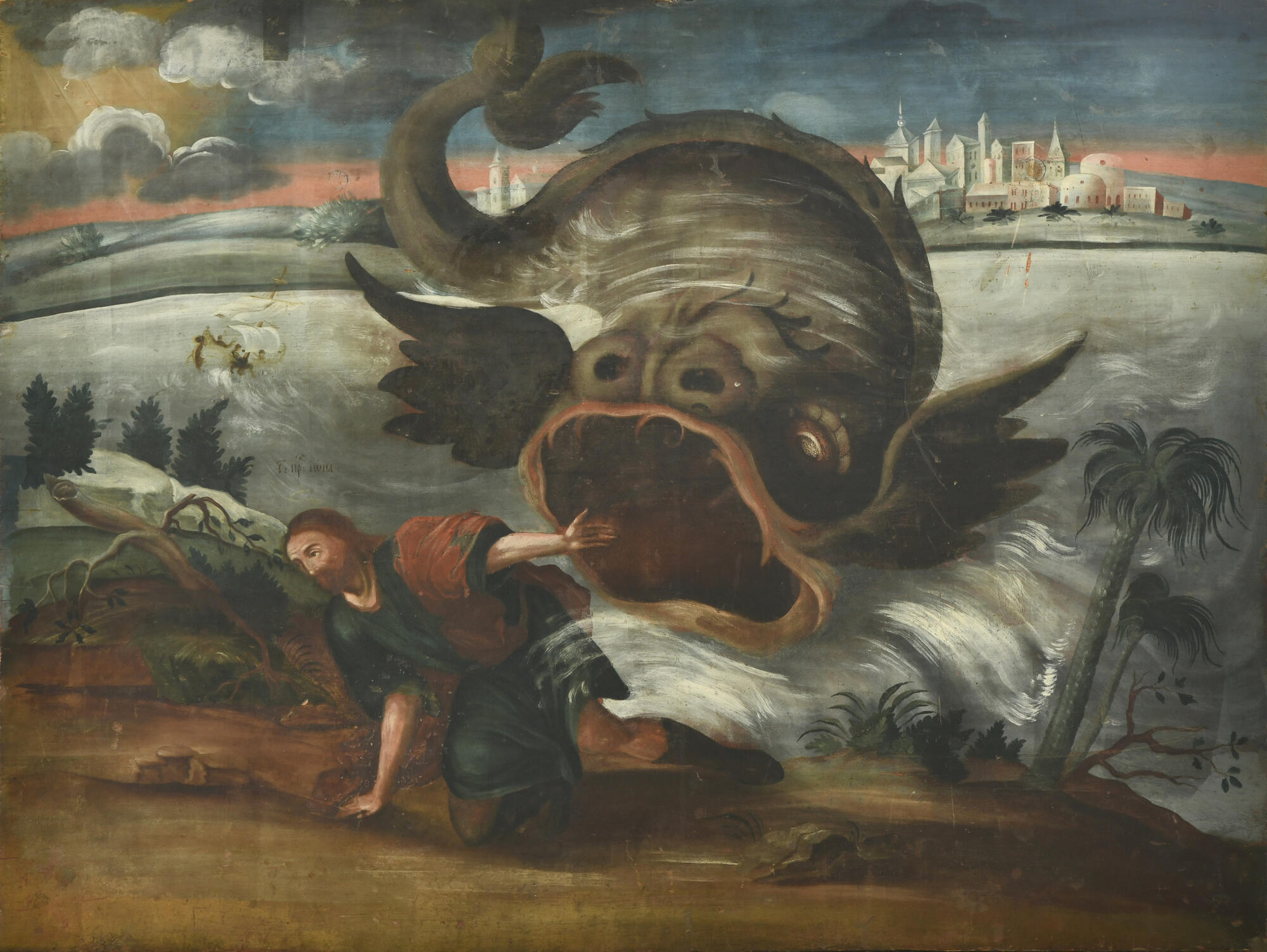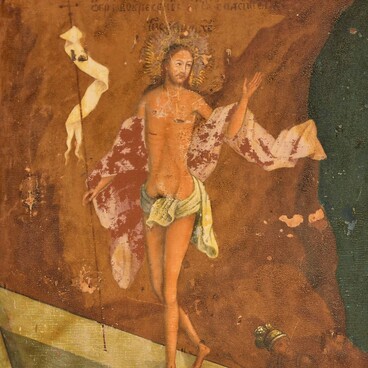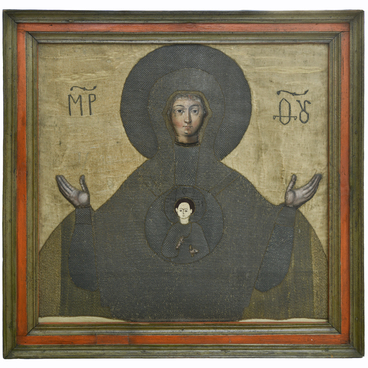It is believed that the icon ‘Jonah in the belly of the Whale’ used to be housed in the Tobolsk Church of the Resurrection — people called it the Church of Saints Zechariah and Elisabeth, after one of the chapels. The icon came to the museum from the city prison. It is a variant of the icon associated with the biblical story of the prophet Jonah. Scripture tells us that God told Jonah to go to the city of Nineveh and preach there. But the prophet disobeyed and sailed to a completely different place. There was a great sea storm. Jonah thought it was God’s wrath for his disobedience, and asked the sailors to throw him into the sea. There, a huge whale swallowed the prophet, and three days later, it vomited Jonah onto dry land near Nineveh alive and unharmed.
The large whale with a huge mouth is in the center of the icon — its nostrils swollen and its eyes are wide open. In the background on the left, there is a sinking ship and some people in the stormy sea. There is a city with high towers on the right.
In the foreground, an unknown artist placed the figure of Jonah rising from the ground. The sandy shore is covered with small patches of vegetation. There is a branch broken by the storm on the left side.
The story of the prophet Jonah is a fairly rare subject in Orthodox iconography. But his image is often found in the works of famous artists: Michelangelo, Tintoretto, and Gustave Dore. The prophet was also depicted in medieval manuscripts — German, Greek, and even Iranian. In Islam, Jonah is venerated under the name of Yunus and is considered to have preached in Nineveh a belief in one God.
Modern theologians suggest that the three days Jonah spent in the whale’s belly are an Old Testament prototype of the three days between Christ’s execution and resurrection when his body was in the tomb. And some scholars are trying to establish how plausible Jonah’s story is and what kind of sea animal could swallow him and then bring him back to land alive. Scripture mentions a whale, but real whales are not capable of swallowing large prey: their throats are too narrow. Researchers speculated that it might have been a cachalot or an orca. As proof of this hypothesis, they cite a case that occurred in the 19th century near the Falkland Islands. The whaling boat of the ship Star of the East was wrecked by a giant cachalot, and one of the crew, James Bartley, had gone missing. The animal, wounded by a harpoon, soon died, and the sailors lifted its carcass aboard the Star of the East. When they began to carve the cachalot, they found their missing companion in its stomach — unconscious but alive. Bartley was not physically injured, but the cachalot’s gastric juice made his skin unnaturally white.
The large whale with a huge mouth is in the center of the icon — its nostrils swollen and its eyes are wide open. In the background on the left, there is a sinking ship and some people in the stormy sea. There is a city with high towers on the right.
In the foreground, an unknown artist placed the figure of Jonah rising from the ground. The sandy shore is covered with small patches of vegetation. There is a branch broken by the storm on the left side.
The story of the prophet Jonah is a fairly rare subject in Orthodox iconography. But his image is often found in the works of famous artists: Michelangelo, Tintoretto, and Gustave Dore. The prophet was also depicted in medieval manuscripts — German, Greek, and even Iranian. In Islam, Jonah is venerated under the name of Yunus and is considered to have preached in Nineveh a belief in one God.
Modern theologians suggest that the three days Jonah spent in the whale’s belly are an Old Testament prototype of the three days between Christ’s execution and resurrection when his body was in the tomb. And some scholars are trying to establish how plausible Jonah’s story is and what kind of sea animal could swallow him and then bring him back to land alive. Scripture mentions a whale, but real whales are not capable of swallowing large prey: their throats are too narrow. Researchers speculated that it might have been a cachalot or an orca. As proof of this hypothesis, they cite a case that occurred in the 19th century near the Falkland Islands. The whaling boat of the ship Star of the East was wrecked by a giant cachalot, and one of the crew, James Bartley, had gone missing. The animal, wounded by a harpoon, soon died, and the sailors lifted its carcass aboard the Star of the East. When they began to carve the cachalot, they found their missing companion in its stomach — unconscious but alive. Bartley was not physically injured, but the cachalot’s gastric juice made his skin unnaturally white.



